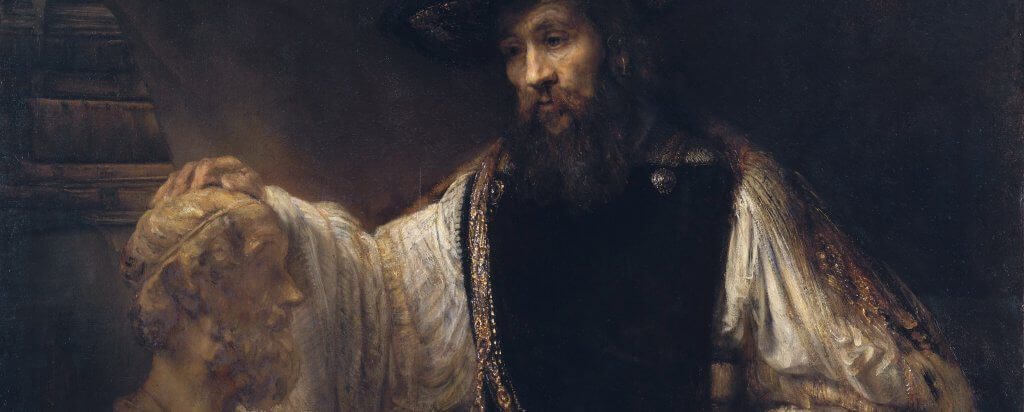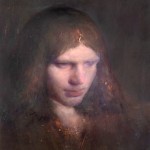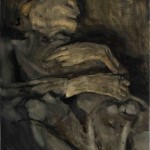News and Articles › Paintings and drawings Philosophy show-home
There is a general impression that self-expression is liberating. However, the culture’s obsession with the self and the requirement of personal expression can in fact be limiting and pressuring as well. Students at art academies – that is, classical academies – are concerned with how, after ended studies, they can express themselves, how they can get their personality into their works.
This paper seeks to calm down those who are stressed about finding a personal expression. You don’t have to. And, as a matter of fact, if you want your work to reach long-lasting relevance and admiration, I argue that you ought not to.
In ancient Greece, and in the Renaissance, finding a personal expression when practicing one’s craft was not a concern as it is among artists of today. Ancient Greece and the Renaissance are characterized by a different value system than the defining value system of today’s art world. The ideas that were crucial in making the Renaissance possible were to a large degree the ideas of the ancient Greek philosopher Aristotle. His book the Poetics inspired imitators; what he wrote about poets counts more or less directly for painters, sculptors, and musicians as well, with that in common of being imitators of nature. Aristotle wrote:
The poet himself ought to say very little; for it is not by virtue of what he says himself that he is an imitator.1
— Aristotle, Poetics
Aristotle’s philosophy concerning the role of the imitator stands in sharp opposition to the modernist aesthetics, which has self-expression as its mantra. It is useful to analyze this alternative path of Aristotle, where the painter seeks an impersonal painting – a work with a limited voice.
The Aristotelian philosophy presented in this paper makes the basis of Odd Nerdrum’s kitsch philosophy, which is an alternative to the values of today’s aesthetics of Fine Art.
A philosophical attitude involves attempting to look beyond the values that constitute consensus. It is useful to illustrate the consensus, here represented by two quotes by the artist Jackson Pollock:
Painting is self-discovery. Every good artist paints what he is.2
It doesn’t matter how the paint is put on, as long as something is said.3
— Jackson Pollock
and compare the consensus to an alternative view, presented in the words of “The Great Kitsch Meister” Andrew Wyeth:
I don’t want my personality to be [in the pictures]. I want the pictures to be the personality.4
— Andrew Wyeth
Pollock’s quotes reflect one of the prevailing modern aesthetic values: The glorification of the artist’s Self. A good artist, according to him, expresses his personality in the artwork, and uses his art to make statements. In short, he makes the artwork personal. The quote by Wyeth, on the other hand, illustrates the valuation of a painter with a limited personal voice, seeking the impersonal painting.
Perspective versus Voice
Before exploring benefits of a limited voice, or an impersonal work, it is important to differ between an individual perspective and a personal voice.
The individual perspective is inevitable and tells “This is life as I see it.” If cultivated and studied, the personal perspective may function to treat each object of study as subjects, and it thus has potential to be of intimate character (i.e. the opposite of disinterestedness).
The personal expression, on the other hand, is an additional individual statement on top of the already established individual perspective (which is inevitable). Uttering one’s personal voice in a work is a conscious decision. Personal expression is uttered through a kind of language, and is thereby predisposed to use collective terms to describe the object.
The Virtues of a Limited Voice:
1. An impersonal painter treats the painting itself as the product. The painting is thus treated as the object of evaluation
Imagine that you are painting a self-portrait:
- First, you seek to establish likeness to the model.
- If you’re skilled, you manage to depict a certain emotion in the face of the model.
- A master painter will even be able to depict a story about the model in the portrait.
Unfortunately, such a painting is likely to get you kicked out of art school. Unless, of course, you turn it upside-down or add some dots of pink paint to it, etc. In short, unless you are saying something through your painting.
This is an illustrating example of the difference between the personal and impersonal painting. It is a misunderstanding to think that an impersonal painting is not emotional – it is possible to strive towards depicting emotions in a painting, without expressing personal feelings. Where does this notion of placing the self in the center, when practicing a skill, come from? Although the Romantic period often is defined as “the birth of individualism,” the general thought of looking for something beyond the painting is much older. The discussion of the nature of mimesis – representation of nature – is ancient.5

Plato and Aristotle [From Raphael’s fresco “The School of Athens”]
One has what generally can be called the Platonists on the one side, valuing what is beyond the work – that which cannot be seen. This “hidden” aspect can be a religious divinity, truth, or – in this case – the self.
On the other side, one has what can be called the Aristotelians, valuing the empirical work itself as a craft. When depicting emotions, it is in order to communicate a story or to make the painting have an as powerful effect as possible.
Fine Art places the Self of the artist in the center, as the object of critique. Many representational painters enter into this “trap” of feeling the need to “say something” through their works and make the paintings personal. I call it a “trap” because centering on the personality of the artist, the self-expression, happens at the expense of the painting’s status as a craft.
If the personal voice, or self-expression, is a key issue, then the critics are looking for something “beyond” the work itself. The painting and the technical execution of it becomes secondary matter, if it becomes a matter at all. Art is today generally established as separate from craft. The phrasing often used is that art is something “more” than craft.
A painter who decides to express his personal voice in his work invites the audience and critics to look at something else that the painting. Upon reflection, this way of drawing the attention away from the execution of the work is an effective strategy for a less skilled painter.
And, vice versa: If one is a skilled painter, it is a failed strategy to express one’s personal voice in your painting – because the mastery of one’s craft, towards which one has strived, will not be in the center of attention.
2. Storytelling flourishes when the story, not the storyteller, is in focus
The Self is of little importance in a kitsch work. It does not matter who the painter is or what he or she may think about any topic of the current.
Nerdrum has said that he started painting because he wanted to tell stories. When looking at the many classical masterpieces of the past depicting stories from the Bible, or from ancient myths, it seems likely that the urge to tell stories is common for many of the classical painters. When being told a story, the quality of the experience of the listener depends on the quality of the storyteller. One disturbing element when telling a story, I argue, is the inclusion of the storyteller’s personal voice.
This point leads to the second virtue of the impersonal painting: Storytelling flourishes when keeping the story, not the storyteller, in focus.
Imagine sitting around a bonfire in the night with fellow men telling stories, and the storyteller starts on telling the Norse creation myth – he tells about how the giant Ymir fell asleep and the first man and woman started to grow out under his arms. Then, he suddenly exclaims, “Obviously, I don’t believe any of this to really have happened.” Personally, I would have asked him to shut up and continue the story. His personal opinion is a disturbance. When including his own opinion, he did not engage in storytelling, but rather in an act of self-expression.
Aristotle wrote in the Poetics:
Homer deserves to be commended on many grounds, but mainly because he alone among the poets knew what his own role should be. The poet himself ought to say very little; for it is not by virtue of what he says himself that he is an imitator.6
— Aristotle, Poetics
Homer’s stories are so impersonal that some scholars even doubt whether Homer ever truly existed, some believe the Iliad and the Odyssey are myths written down by several people over generations, under the pseudonym of “Homer.”7 Homer appears to be the ultimate example of an impersonal imitator of nature.
3. An impersonal painting invites to comparison – and thence to improvement
Any sensible person would not compare an artwork by Warhol to a painting by Rembrandt. Why is this the case? One reason for this, I argue, is that one of the paintings is personal, namely that of Warhol.
Warhol engages in self-expression, which means that the artworks include expressions that depend on the artist, and the artist’s mind. Here, the inner ideas are important. Rembrandt, on the other hand, engages in imitation, which means that the work is sufficiently independent of the painter and his mind to be concrete and comparable to other works. A Rembrandt painting can for instance be compared to a Titian painting because both of them are sufficiently independent from their creator’s mind.8 They are empirical products not based on vague metaphysical ideas, such as the self.
What, then, is the value of being able to compare works?
One can steal! Isn’t that wonderful?
It is believed that Rembrandt later in his life saw some of Titian’s late works. Rembrandt compared Titian’s works to his own works, and ended up using some of the same techniques. What Rembrandt “stole” from Titian was not something personal, but techniques available to everyone. The personal, on the other hand, depends on the inner life of the creator and cannot be stolen.
Rembrandt improved his craftsmanship by stealing techniques from others. This was how the practice was: painters stole techniques and ideas from each other. Note that there is nothing morally wrong about stealing good techniques. Another word for stealing, in this sense, is “learning.” One can learn from each other. Learning leads to improvement. Constant improvement through learning from other is virtuous.
An impersonal painter is open to learn (i.e. steal) from other impersonal painters, and thus become a better and more skilled painter. Nerdrum has said the following about the core of kitsch: “It is not who you are that is important, but what you can do!”
An impersonal work stands better on its own. It speaks for itself. One does not care much about who sculpted a Rodin sculpture, or painted the Mona Lisa. Of course, one can have a fascination for the sculptor or the painter, but knowing who the creator is does not increase the quality of the work. Creating a piece that speaks for itself is demanding and extremely difficult. Therefore, it is convenient to be able to steal – or learn – from others.
4. An impersonal painting exceeds the personal – and that is when the magic begins
Before moving on, it is beneficial to clarify that “impersonal” in the context of this paper does not equal “objective.” Neither does it equal “disinterest.” Rather on the contrary. Paintings can very well be impersonal without being objective, in the sense of being naturalistic or expressing something true.
Again, it is wise to turn to the most influential philosopher for the kitsch philosophy, Aristotle, who distinguishes between the role of the historian and the role of the philosopher. The role of the historian is to set down what actually happened, with no regard to unity.
“…it is not the poet’s function to describe what actually happened. He has to describe what can happen, that is, what is possible because it is either likely or necessary. […] That is why poetry is more philosophical and serious that history. Poetry describes the universal, whereas history deals with particulars. There is universality when we have to deal with likely or necessary sayings and deeds of a man of a certain stamp.”9
A poetic painter, in the Aristotelian sense, is concerned with depicting the universal – in an impersonal manner. The purpose of portraying the universal is for the picture to throw light on what is beyond the particular.
For instance, the success of a self-portrait painted by a skilled painter is measured not on its likeness to the model alone (which is a necessary, but not sufficient, condition), but also on its ability to make the audience familiarize with it. Thus, a successful self-portrait can throw light on other individuals and hence increase our knowledge and understanding.
If you manage to reach beyond the personal, you have managed something difficult. Let me mention an example: My piano teacher, Tatjana Tun, once expressed about Beethoven’s Sonata Pathetique, second movement: “Beethoven’s Pathetique is about peace. Not personal peace between Beethoven and his neighbor. It is about world peace!”
In order to enter the realm of the eternal, one must exceed the personal expression. A work that depicts something that is everlastingly relevant for any human – in short, a view that is broader than the personal and broader than the present – depicts something universal. One depicts a common individuality and acknowledges a so-called “pastness of the present.” An impersonal painting has the potential of making the work better than the person who has made it. The theme is about something out there, something outside the painter himself. An appeal to emotions through empathy is a way of appealing to the common individuality.
5. Through superficiality, the impersonal painting reaches depth
Ayn Rand has claimed in her aesthetic theory that if one paints everything, there is no need to paint at all. Rand used the example of painting a beautiful woman who has a cold sore. Normally, one’s general impression of the woman would ignore the cold sore and simply see a beautiful woman. If the painter included the cold sore in the painting, Rand argued this depction would be “a vicious attack on man, on beauty […].”10 In other words, a painter ought to make choices when painting, as a selection process, in order to evoke the intended feelings among the audience.
Some would claim that such choices when painting constitute a kind of self-expression. However, that would be a misunderstanding. If any conscious decision equals self-expression, then self-expression become a term too broad to be useful. Emphasis and prioritization are ways of imitating how the outer world appears, so the question is not whether one should make choices and prioritize or not. This discussion concerns self-expression as an attempt to communicate inner life.
At first, it might seem like a conflict between Aristotle’s statement of reducing the role of the self and the kitsch tradition of painting vast amounts of self-portraits. However, this is in fact not a conflict, because the inner self is of little importance for a kitsch painter in action – even when painting a self-portrait. Nerdrum has said: “A painter using the old master style is sensual. His aim is to become engrossed in his work and skillfully render life’s eternal moments without prejudice.”11 Here, I understand “prejudice” to mean “personal expression” – after all, being personal consists of being prejudiced.
In contrast, Immanuel Kant, argues that the way to reach universality is to exclude interest.12 That is, interest in the object of portrayal. A painting of a nude sensual woman is interesting, and thus not supposed to be portrayed (at least not in a sensual manner). In my opinion, Picasso is a prime example of a self-expressing painter. His portraits of women are not sensual, but have a distance to the women portrayed by stylizing the figures towards the abstract.
Somewhat paradoxically, the personal expression does not equal intimacy. Self-expression is disinterest towards the object portrayed. It appears to be the case that the personal has to be expressed as a statement, as the inner cannot be expressed directly – it must be channeled and objectified. The personal voice is uttered through a kind of language, and is thereby predisposed to use collective terms as the means of expression.
The impersonal is not disinterestedness, but the opposite; the impersonal appeals to what is common to individuals: the sensual. What this means is that it does not matter who the painter is or what he or she may think about any topic in current politics. I.e. the painter’s “voice” is not meant to be expressed. It is the study of the outer self that matters.
Imitation is about understanding, and dwelling into, the object of depiction. The empirical reality is there to be studied. At best, the painter can treat the object as an intimate subject, having a relationship to the object. The superficial approach, or the dwelling into the physical outer reality, achieves depth in virtue of becoming intimate.
- Aristotle. “Poetics.” Translated by A. E. Wardman and J. L. Creed. In The Philosophy of Aristotle, edited by R. Bambrough. New York, New York: Signet Classics, 2011.§24. (1460a)
- Erika Doss, Benton, Pollock, and the Politics of Modernism: From Regionalism to Abstract Expressionism (University of Chicago Press) 1995, p. 353
- Interview by William Wright, Summer 1950 (for broadcasting, but never used); as quoted in Abstract Expressionism: Creators and Critics, ed. Clifford Ross, Abrahams Publishers, New York 1990, p. 145.
- Interview by Charles Osgood. Andrew Wyeth. CBS Sunday Morning. July 13, 1997.
- For a thorough discussion about the nature of mimesis through the ages, see: Halliwell, Stephen. The Aesthetics of Mimesis.Princeton, New Jersey: Princeton University Press, 2002.
- Aristotle. “Poetics.” Translated by A. E. Wardman and J. L. Creed. In The Philosophy of Aristotle, edited by R. Bambrough. New York, New York: Signet Classics, 2011.§24. (1460a)
- For a discussion on the ”Homeric Question,” see for instance: Jensen, Minna Skafte. The Homeric Question and the Oral-Formulaic Theory. D. Appleton and Company, 1980.
- It is possible to argue that no product can be completely independent of its creator. That is, in part, true. It has already been established that all humans have an inevitable individual perspective. However, it is not an argument against seeking a kind of independence as a value. In democracy, personal freedom is a value. One can argue that complete personal freedom is impossible to reach. That might be true, but one can still strive towards personal freedom as a value.
- Aristotle. “Poetics.” Translated by A. E. Wardman and J. L. Creed. In The Philosophy of Aristotle, edited by R. Bambrough. New York, New York: Signet Classics, 2011.§9. (1451a36-1451b9).
- Rand, Ayn. 1969, The Romantic Manifesto: A Philosophy of Literature, New American Library, New York, NY. p. 24.
- Nerdrum, Odd. 2011, “Kitsch – The Superstructure of Sensuality.” In Kitsch – More than Art, by Odd Nerdrum et al., Schibstad Forlag, Oslo. p. 32.
- Immanuel Kant, Critique of Judgment, Translated by J. H. Bernard, New York: Hafner Publishing, 1951.Section 8.
Published on Sunday, May 13th, 2018






Muy interesante lectura. Incita a reflexionar adecuadamente sobre las ideas que vienen expresadas. Festina lente.